Before you begin this tutorial, it is recommended that you complete HM-1000: Getting Started with HyperMesh and Exploring the ANSYS Interface.
In this tutorial you will learn how to set up surface to surface contacts. In HyperMesh, you can create contact pairs manually or with the Autocontact tool. In this exercise you will learn how to set up contacts manually.
The steps mentioned in this tutorial are only applicable for HyperMesh 14.0.130 and on.
Model Files
This exercise uses the hm-ansys_contact_manager_3-d_tutorial.hm file, which can be found in <hm.zip>/interfaces/ansys/. Copy the file(s) from this directory to your working directory.
Exercise
Step 1: Load the ANSYS User Profile
| 1. | Start HyperMesh Desktop. |
| 2. | In the User Profile dialog, set the user profile to Ansys. |
Step 2: Retrieve the HyperMesh Model File
| 1. | From the menu bar, click File > Open > Model. |
| 2. | In the Open Model dialog, open the hm-ansys_contact_manager_3-d_tutorial.hm file. A model loads in the graphics area. |
| 3. | If the load collector is displayed, in the Model browser, click  next to the load collector to turn off the display of its elements. next to the load collector to turn off the display of its elements. |
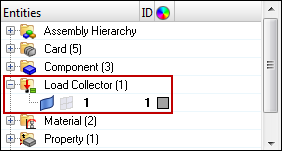
| 4. | In the graphics area, click once to make it the current window for keyboard commands. |
| 5. | Fit the model to the graphics area by pressing f. |
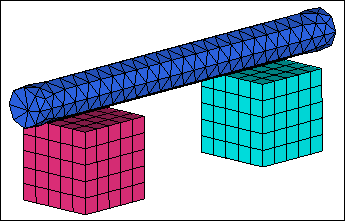
Step 3: Create a Contact Pair
| 1. | Open the Contact browser from the menu bar by clicking View > Browsers > HyperMesh > Contact. |
| 2. | In the second pane of the Contact browser, right-click and select Create > Contact Pair from the context menu. HyperMesh creates and opens a contact pair in the Entity Editor. |
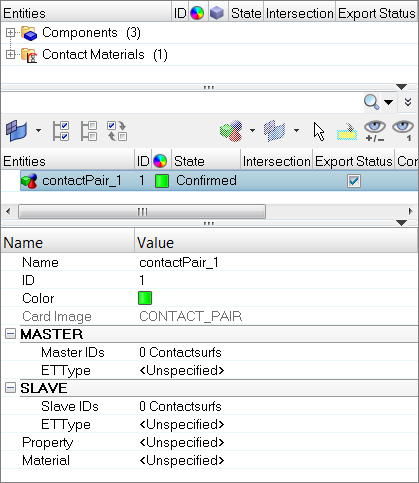
Step 4: Create and Attach a Contact (Master) Surface
| 1. | Mask the BOX_SOLID45 and CYLINDER_SOLID45 components. |
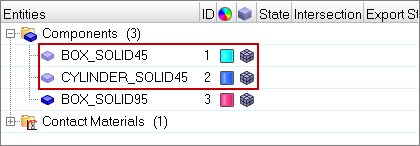
| 2. | In the second pane of the Contact browser, select contactPair_1. |
| 3. | Create and attach a contact (master) surface. |
| a. | In the Entity Editor, right-click on Master IDs and select Create from the context menu. |
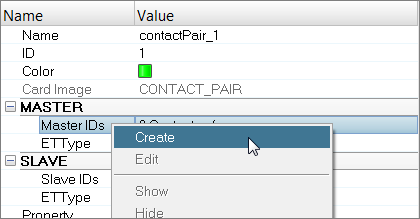
| b. | In the Create Contactsurfs dialog, for Elements, click 0 Elements >> Elements. |
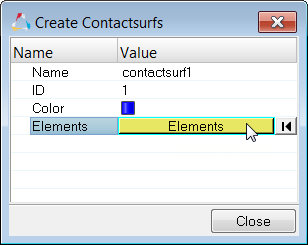
| c. | In the panel area, set the first switch to add solid faces. |
| d. | Set the advanced selection switch to faces. |

| e. | Select the top faces of the cube as indicated in the image below. |
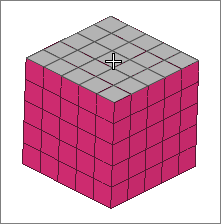
| g. | Observe the newly created contact surfaces. The normals of the surface are pointing outwards. By default, when contact surfaces are created over solid element faces, normals point outwards. |
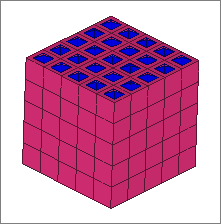
| h. | In the panel area, click return. |
| i. | In the Create Contactsurfs dialog, click Close. |
| 4. | Create and attach an Et Type to the contact surface. |
| a. | In the Entity Editor, under MASTER, right-click on ETType and select Create from the context menu. |
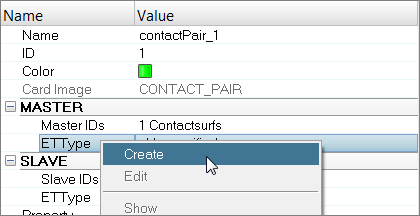
| b. | In the Create Sensors dialog, the Element Type is set to CONTA174. |
| c. | Enable KeyOpt12, then select 0-Standard from the list. |
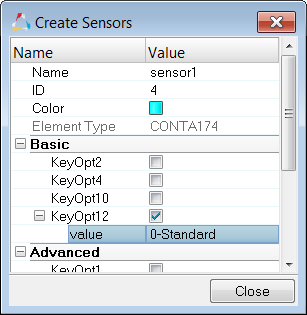
Step 5: Create and Attach a Target (Slave) Surface
The bottom half of the CYLINDER_SOLID45 component will be used as the target surface.
| 1. | Unmask the CYLINDER_SOLID45 component, and mask the BOX_SOLID45 and BOX_SOLID95 components. |
| 2. | On the Standard Views toolbar, click  to orient the model to the XY top plane view. to orient the model to the XY top plane view. |
| 3. | Create and attach a target (slave) surface. |
| a. | In the Entity Editor, right-click on Slave IDs and select Create from the context menu. |
| b. | In the Create Contactsurfs dialog, for Elements, click click 0 Elements >> Elements. |
| a. | In the panel area, set the first switch to add solid faces. |
| b. | Set the advanced selection switch to elems. |

| c. | Select the elements indicated in the image below. |
Tip: Quickly select elements with window selection by pressing SHIFT while clicking and dragging your mouse.
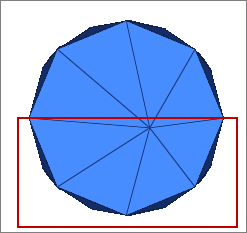
| d. | Using the nodes selector, select face nodes on the selected elements. |
| e. | Click add. Surfaces are created on selected elements. |
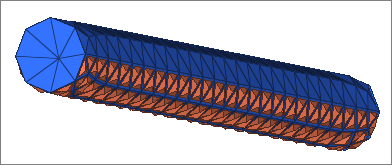
| f. | In the panel area, click return. |
| g. | In the Create Contactsurfs dialog, click Close. |
| 3. | Create and attach an Et Type to the contact surface. |
| a. | In the Entity Editor, under SLAVE, right-click on ETType and select Create from the context menu. |
| b. | In the Create Sensors dialog, the Element Type is set to TARGE170. |
| c. | Enable KeyOpt4, then select 0-All DOF are constrained from the list. |
Step 6: Create and Attach a Property and Material to the Contact Pair
| 1. | Create and attach a contact property. |
| a. | In the Entity Editor, right-click on Property and select Create from the context menu. |
| b. | In the Create Properties dialog, define the property and click Close. |
| 2. | Create and attach a contact material. |
| a. | In the Entity Editor, right-click on Material and select Create from the context menu. |
| b. | In the Create Materials dialog, define the material and click Close. |
| • | Set Card Image to MPDATA. |
| • | Select the MU (coefficient of friction) checkbox. |
| • | Under MP_MU_LEN=, next to Data: C, click  . . |
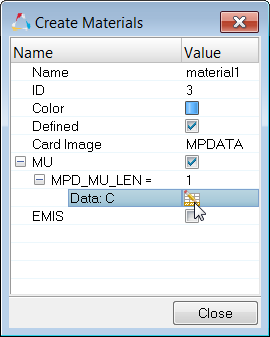
| • | In the MP_MU_LEN= dialog, enter -0.45 and click Close. |
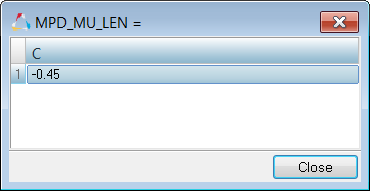
Step 7: Review the Contact Pair
| 1. | In the browser, unmask all of the components and contact surfaces. |
| 2. | In the second pane of the browser, right-click on contactPair_1 and select Isolate Only from the context menu. Only the master and slave surfaces display. |

| 3. | Check the normals of the surfaces. Notice how the surfaces are pointing out. If the normals are facing each other then it is a valid direction. In this tutorial, the normals should be pointing each other. |
| 4. | When you are done reviewing, turn the display of all entities back on. |
| 5. | Right-click on contactPair_1 and select Review from the context menu. Contact regions display. |
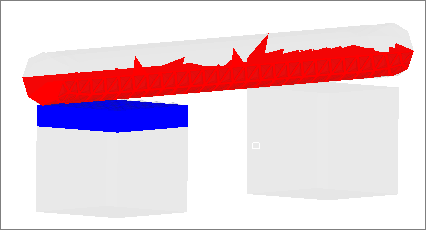
| 6. | When you are done reviewing, right-click on contactPair_1 and select Reset Review from the context menu. |
Step 8 (Optional): Add /SOLU and SOLVE in the Control Cards
If your model needs to be solved in ANSYS, add the following control cards.
| 1. | Open the Control Cards panel by clicking Setup > Create > Control Cards from the menu bar. |
| 2. | Click /SOLU to exit the PREP7 preprocessor and enter the SOLU preprocessor. |

| Note: | If you do not see the SOLVE control card, click next. |

| 5. | Click return to exit the card image. |
| 6. | Click return to exit the Control Cards panel. |
See Also:
HyperMesh Tutorials




























